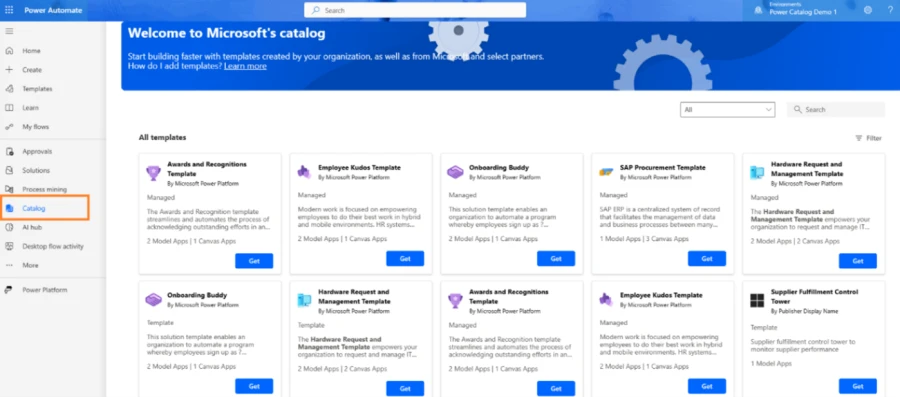
Enable reusability and maintain best practices with the catalog in Microsoft Power Platform
When building solutions in Microsoft Power Apps and Microsoft Power Automate, your organization may have company-specific needs and complex scenarios, such as custom mappings to various data sources, multi-faceted flows and triggers, and embedding various components with custom logic into apps. There is also repetitive work, such as implementing delicate design patterns, branding, and reusing links. Creating all this from scratch every time is a waste of time and is an error prone process. Organizations also want to drive toward maintainable patterns and consistency for their makers.

Catalog in Power Platform
Share and install reusable assets, such as apps, flows, connectors, and prompts, customized for your organization.
The catalog in Power Apps and Power Automate is now generally available to the public. The catalog enables makers to share and install reusable assets, such as apps, flows, connectors, prompts, and more, that are customized for your organization, by your organization. This provides much more useful starting points than simple and generic templates. In addition, because the catalog is built on top of our solutions framework, you can also easily install catalog items from any environment in a tenant, and have catalog assets accessible from authoring experiences, like Canvas Studio and flow designer.

You can publish assets as a template or as a managed item. Templates are pure copies that any makers can utilize as they wish. Managed items are more tightly controlled and can be republished with updates over time so that your organization uses the most recent, authoritative version across environments.

Please note that you will need a managed environment to publish assets in the catalog as part of general availability. However, all assets can be installed from any environment, even ones that are not managed.
Using the catalog in Power Apps and Power Automate
Customers are using the catalog for a variety of scenarios, including:
- Saving templates for reuse across environments.
- Bundling components into a collection for specific departments to utilize.
- Spinning up multiple catalogs and seed with sample data and apps for demo purposes.
- Using the assets of a managed item as is and making no changes.
- Building custom functionality on top of the assets in the managed item without changing the original components.
- Using the assets to assist with building their own solutions. For example, Power Apps component framework components, custom connectors, and so on.
- Partners are also using the catalog to streamline the process of building solutions and curating components for multiple customers at the same time across environments.
The catalog is highly flexible to handle a broad range of use cases, while backed by enterprise level governance and security, which is critical when managing a centralized and shared repository across many makers in a tenant. The catalog comes with comprehensive cross-environment roles and permissions, additional publishing groups to control who can make updates, administration and approval capabilities, installation tracking, and application lifestyle management (ALM). Organizations where makers can share and reuse artifacts in a controlled and secure environment will get the most out of Microsoft Power Platform.

What our customers are saying about the catalog:
“Through Accenture’s participation in the private preview of Microsoft power catalog, we’ve provided feedback to Microsoft to help them shape a ready-to-use, centrally governed repository that can supercharge application and workflow development. In support of Accenture’s strategy to reuse and scale solution components, we will explore power catalog [during public preview] to help streamline and speed application development cycles, and to drive brand consistency across Accenture applications.”
— Uday Adhikari, [Microsoft] Power Platform lead for North America at Accenture
“5/5. The catalog closes the gap in distributing updates between (product) development, Sales, and Operations departments. For demos, we often require certain versions or special releases. With catalogs we enable everyone to set up the tailored demo by themselves while the product group can maintain pre-release builds at the same time.”
— Sebastain Sieber, Most Valuable Professional, proMX.
The catalog feature will be generally available with the following features:
- Enterprise level roles and permissions to restrict who can publish and install catalog items across environments
- Approval of catalog items by admins before they’re officially published for your organization to use
- A suite of Microsoft-provided components out-of-the-box, such as Enterprise templates
- Low-code and easy-to-use wizards to publish and install items
- A My Activity page to track status and see any error codes for published and installed items
- An administrative workspace to manage catalogs, users, and settings
- And several other features, such as environment variable support, connection checks, a gallery page with comprehensive filters to browse catalog items, and more
Learn more about the catalog in Microsoft Power Platform
To learn more about the catalog, you can read an overview, the usage guide, and administration and setup instructions.
Some features planned on the horizon include:
- Integration with Microsoft Copilot Studio.
- Providing the option to choose the solution you’d like to install catalog items into.
- Allowing makers to choose which solutions should be updated with new versions.
- More post-installation options for different components (such as opening up a specific editor).
- Submitting apps and flows directly into catalog with solution creation/selection as part of the wizard.
- Improved error detection and handling.
You can find the catalog feature in your left navigation in both Power Apps and Power Automate. Contact your admin to help set up the catalog and you can get started right away.
